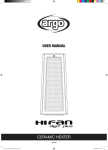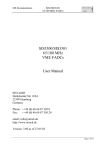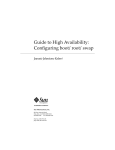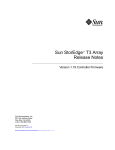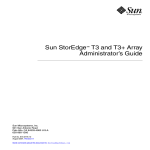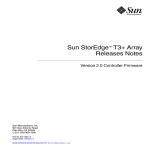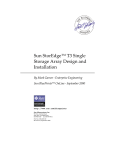Download Sun StorEdge™ T3 Disk Tray Release Notes
Transcript
Sun StorEdge™ T3 Disk Tray Release Notes Note - Users should be aware that both the Sun StorEdge T3 and StorEdge T300 names refer to the same product and are equivalent in terms of product features and functionality. The Sun StorEdge T3 disk tray was previously known as the Sun StorEdge T300 prior to product shipment. Most user documentation has been updated to reflect the new name; however, there are some software components and other related documentation that still reference this product as the Sun StorEdge T300. Note – This document pertains to controller firmware level 1.16. Sun Microsystems, Inc. 901 San Antonio Road Palo Alto, CA 94303 U.S.A. 650-960-1300 Part No. 806-1497-12 November 2000, Revision A Send comments about this document to: [email protected] Copyright 2000 Sun Microsystems, Inc., 901 San Antonio Road • Palo Alto, CA 94303-4900 USA. All rights reserved. This product or document is protected by copyright and distributed under licenses restricting its use, copying, distribution, and decompilation. No part of this product or document may be reproduced in any form by any means without prior written authorization of Sun and its licensors, if any. Third-party software, including font technology, is copyrighted and licensed from Sun suppliers. Parts of the product may be derived from Berkeley BSD systems, licensed from the University of California. UNIX is a registered trademark in the U.S. and other countries, exclusively licensed through X/Open Company, Ltd. For Netscape Communicator™, the following notice applies: Copyright 1995 Netscape Communications Corporation. All rights reserved. Sun, Sun Microsystems, the Sun logo, AnswerBook2, docs.sun.com, SunSolve, Sun StorEdge, and Solaris are trademarks, registered trademarks, or service marks of Sun Microsystems, Inc. in the U.S. and other countries. All SPARC trademarks are used under license and are trademarks or registered trademarks of SPARC International, Inc. in the U.S. and other countries. Products bearing SPARC trademarks are based upon an architecture developed by Sun Microsystems, Inc. The OPEN LOOK and Sun™ Graphical User Interface was developed by Sun Microsystems, Inc. for its users and licensees. Sun acknowledges the pioneering efforts of Xerox in researching and developing the concept of visual or graphical user interfaces for the computer industry. Sun holds a non-exclusive license from Xerox to the Xerox Graphical User Interface, which license also covers Sun’s licensees who implement OPEN LOOK GUIs and otherwise comply with Sun’s written license agreements. RESTRICTED RIGHTS: Use, duplication, or disclosure by the U.S. Government is subject to restrictions of FAR 52.227-14(g)(2)(6/87) and FAR 52.227-19(6/87), or DFAR 252.227-7015(b)(6/95) and DFAR 227.7202-3(a). DOCUMENTATION IS PROVIDED “AS IS” AND ALL EXPRESS OR IMPLIED CONDITIONS, REPRESENTATIONS AND WARRANTIES, INCLUDING ANY IMPLIED WARRANTY OF MERCHANTABILITY, FITNESS FOR A PARTICULAR PURPOSE OR NONINFRINGEMENT, ARE DISCLAIMED, EXCEPT TO THE EXTENT THAT SUCH DISCLAIMERS ARE HELD TO BE LEGALLY INVALID. Copyright 2000 Sun Microsystems, Inc., 901 San Antonio Road • Palo Alto, CA 94303-4900 Etats-Unis. Tous droits réservés. Ce produit ou document est protégé par un copyright et distribué avec des licences qui en restreignent l’utilisation, la copie, la distribution, et la décompilation. Aucune partie de ce produit ou document ne peut être reproduite sous aucune forme, par quelque moyen que ce soit, sans l’autorisation préalable et écrite de Sun et de ses bailleurs de licence, s’il y en a. Le logiciel détenu par des tiers, et qui comprend la technologie relative aux polices de caractères, est protégé par un copyright et licencié par des fournisseurs de Sun. Des parties de ce produit pourront être dérivées des systèmes Berkeley BSD licenciés par l’Université de Californie. UNIX est une marque déposée aux Etats-Unis et dans d’autres pays et licenciée exclusivement par X/Open Company, Ltd. La notice suivante est applicable à Netscape Communicator™: Copyright 1995 Netscape Communications Corporation. Tous droits réservés. Sun, Sun Microsystems, the Sun logo, AnswerBook2, docs.sun.com,SunSolve, Sun StorEdge, et Solaris ont des marques de fabrique ou des marques déposées, ou marques de service, de Sun Microsystems, Inc. aux Etats-Unis et dans d’autres pays. Toutes les marques SPARC sont utilisées sous licence et sont des marques de fabrique ou des marques déposées de SPARC International, Inc. aux Etats-Unis et dans d’autres pays. Les produits portant les marques SPARC sont basés sur une architecture développée par Sun Microsystems, Inc. L’interface d’utilisation graphique OPEN LOOK et Sun™ a été développée par Sun Microsystems, Inc. pour ses utilisateurs et licenciés. Sun reconnaît les efforts de pionniers de Xerox pour la recherche et le développement du concept des interfaces d’utilisation visuelle ou graphique pour l’industrie de l’informatique. Sun détient une licence non exclusive de Xerox sur l’interface d’utilisation graphique Xerox, cette licence couvrant également les licenciés de Sun qui mettent en place l’interface d’utilisation graphique OPEN LOOK et qui en outre se conforment aux licences écrites de Sun. CETTE PUBLICATION EST FOURNIE "EN L’ETAT" ET AUCUNE GARANTIE, EXPRESSE OU IMPLICITE, N’EST ACCORDEE, Y COMPRIS DES GARANTIES CONCERNANT LA VALEUR MARCHANDE, L’APTITUDE DE LA PUBLICATION A REPONDRE A UNE UTILISATION PARTICULIERE, OU LE FAIT QU’ELLE NE SOIT PAS CONTREFAISANTE DE PRODUIT DE TIERS. CE DENI DE GARANTIE NE S’APPLIQUERAIT PAS, DANS LA MESURE OU IL SERAIT TENU JURIDIQUEMENT NUL ET NON AVENU. Please Recycle Sun StorEdge T3 Disk Tray Release Notes Introduction This document contains important information about the Sun StorEdge™ T3 disk tray that was not available at the time the product documentation was published. Review this document so that you are aware of issues or requirements that can impact the installation and operation of the disk tray. The information in this document supplements the information contained in the Sun StorEdge T3 Disk Tray Installation, Operation, and Service Manual and the Sun StorEdge T3 Disk Tray Administrator’s Guide. Use this release note in conjunction with other release notes and README files that you may have received with other software products related to the Sun StorEdge T3 disk tray, such as Sun StorEdge Component Manager software and VERITAS Volume Manager. These release notes are organized as follows: ■ ■ ■ ■ ■ ■ ■ ■ ■ “Required Patches” on page 2 “Required Firmware” on page 3 “Diagnostics Issue” on page 4 “VERITAS Issues” on page 4 “Service Issues” on page 6 “System Level Issues” on page 8 “EPROM Issues” on page 10 “Hardware Updates” on page 11 “Command-Line Error Messages” on page 12 1 Required Patches Install all the required patches listed below before installing the Sun StorEdge T3 disk tray. These patches are available on the SunSolve™ web site: http://sunsolve.sun.com. From the SunSolve web site, select Patches under the SunSolve Online column, then select the Storage Products option from the Patches web page. Refer to the README file on the web page for specific details on upgrading the firmware. Note – You may need other patches not listed below for related software products such as Component Manager or VERITAS Volume Manager. Refer to the SunSolve web site and to the release notes of these products for their required patches. System Type All SolarisTM 2.6 Operating Environment Solaris 7 Operating Environment Solaris 8 Operating Environment 105356-16 or later (ssd driver) 107458-10 or later (ssd driver) 109524-02 or later (ssd driver) 106226-01 or later (format patch) 107473-06 or later (luxadm patch) 105181-23 or later (kernel update patch) 107834-03 or later (DKIO Extensions Patch) 106541-12 or later (Kernel Update Patch) Sun StorEdge T3 disk tray 109115-04 firmware patch 109115-04 firmware patch 109115-04 firmware patch VERITAS 3.0.4 110257-01 110258-01 110259-01 VERITAS 3.1 110034-01 110035-01 110036-01 PCI (ifp) Only 107280-07 or later (ifp/PCI driver/PCI Systems only) 107292-07 or later (ifp/PCI driver/PCI Systems only) 109189-02 or later (ifp/PCI driver/PCI Systems only) 109399-02 or later (PCI Host Adapter Firmware Fcode) 109399-02 or later (PCI Host Adapter Firmware Fcode) 109399-02 or later (PCI Host Adapter Firmware Fcode) 2 Sun StorEdge T3 Disk Tray Release Notes • November 2000 System Type SBus/sf-socal Only SolarisTM 2.6 Operating Environment Solaris 7 Operating Environment Solaris 8 Operating Environment 105375-25 or later (sf/socal driver/SBus systems only) 107469-08 or later (sf/socal driver/SBus systems only) 109460-03 or later (sf/socal driver/SBus systems only) 109400-03 or later (SBus Host Adapter Firmware Fcode) 109400-03 or later (SBus Host Adapter Firmware Fcode) 109400-03 or later (SBus Host Adapter Firmware Fcode) Required Firmware The latest controller firmware level is available on the SunSolve web site. You can check the controller firmware level on the disk tray using the ver command, as described in the Sun StorEdge T3 Disk Tray Administrator’s Guide. If the disk tray is configured with prerelease controller firmware, in addition to upgrading controller firmware, you must upgrade the *.htm files located in the disk tray /web directory along with other disk tray firmware as described in the Sun StorEdge T3 Disk Tray Installation, Operation, and Service Manual. Note – Refer to the README file associated with the firmware upgrade patch for details on verifying the currently installed firmware level. The latest *.htm files and all other disk tray firmware can be copied from the SunSolve web site: http://sunsolve.sun.com Or contact your Sun representative to obtain the latest firmware releases. Sun StorEdge T3 Disk Tray Release Notes 3 Diagnostics Issue ! Caution – Sun StorEdge T3 disk tray ofdg utility is for service use only. Use of this feature will make data unavailable. The disk tray firmware provides a command-line and graphical user interface to a diagnostics tab provided by Sun StorEdge Component Manager 2.1. The ofdg utility is used to perform offline diagnostic testing. This tool should be used only by qualified Sun service providers at this time. The ofdg utility is limited in its test capabilities and must be run while the system is offline to avoid problems. VERITAS Issues Note – The following VERITAS issues have been resolved: 4241652 and 4282809. 4264118: DMP failback is not automatically enabled (VERITAS Volume Manager 3.0.4 only). After installing the VERITAS software, to ensure correct operation of VERITAS Dynamic Multipathing (DMP) auto failback operations, type the following command (as root) on host systems connected to Sun StorEdge T3 disk trays: # vxdmpadm start restore interval=60 policy=check_all Note – You must run this command after every system reboot. 4 Sun StorEdge T3 Disk Tray Release Notes • November 2000 4282806: vxinstall only displays the first disk tray controller for the configuration. During the vxinstall procedure, only the first connected host bus adapter in a Sun StorEdge T3 disk tray partner group is displayed. This occurs because vxinstall displays only the first path to a disk tray partner group, even though other paths to the partner group have also been detected. This can be misleading since in disk tray configurations, volumes can also exist through second controller data paths. You do not need to take any special action to correct this. Allow vxinstall to proceed to completion. Once the host system has rebooted from the VERITAS installation, all paths to the disk tray are properly recognized by the Volume Manager software. 4313336: Enable DMP support for a Sun StorEdge T3 disk tray and StorEdge A3500 configuration. DMP support is necessary to obtain full redundancy between interconnected disk tray controller units. If you are connecting redundant Sun StorEdge T3 disk trays to a host running DMP that also has StorEdge A3500 storage devices connected to it, you must remove the alternate pathing (AP) file to make sure that both types of storage devices co-exist properly. To perform the following procedure, you must be logged in as root. 1. On the data host, type: # ls -l /kernel/drv/ap 2. If the /kernel/drv/ap file is of 0 length, remove /kernel/drv/ap by typing: # rm /kernel/drv/ap Sun StorEdge T3 Disk Tray Release Notes 5 3. Reboot the system. # reboot If the /kernel/drv/ap file is not of 0 length, AP is installed and you cannot enable DMP because AP and DMP cannot co-exist. Sun Microsystems, Inc. recommends that you remove the AP product entirely using pkgrm (1m). Refer to the AP product documentation for further details. 4253044: Volume usage does not refresh. Within the Volume Manager Storage Administrator (VMSA) product, volume usage information might not be refreshed correctly. If this problem is encountered, restart the VMSA application to update the volume usage statistics. Service Issues Note – The following Service issues have been resolved: 4349602, 4304266, and 4341342. FRU removal for longer than 30 minutes will initiate a partner group shutdown. If any field replaceable unit (FRU) is removed for an extended period of time, thermal complications might result. To prevent this, the Sun StorEdge T3 disk tray is designed so that an orderly shutdown occurs when a component is removed for longer than 30 minutes. Therefore, a replacement part must be immediately available before starting a FRU replacement procedure. You must replace a FRU that has been removed within 30 minutes or the disk tray, and all attached disk trays in that partner group, will shut down and power off. 6 Sun StorEdge T3 Disk Tray Release Notes • November 2000 4374724: Multiple non-adjacent disk failures in a RAID 1 stripe. In the event of multiple non-adjacent drive failures in a RAID 1 volume on a Sun StorEdge T3 disk tray, the volume can be unmounted. Single drive failures within the RAID 1 volume are handled correctly and, in those cases, the RAID 1 volume remains mounted and accessible from the host. 4374280 RAID 0 volumes not recommended with host-based mirroring. In the event of an individual drive failure within a RAID 0 volume on a Sun StorEdge T3 disk tray, that volume remains mounted and accessible from the host. Data errors and other information are reported to the host for I/Os that are unsuccessful due to the failed drive. When RAID 0 volumes are used in conjunction with host-based mirroring software (such as VERITAS Volume Manager), a failed drive can trigger extensive host-side retries. Therefore, if you are configuring a hostbased mirroring solution, use RAID 1 or RAID 5 volumes on the Sun StorEdge T3 disk tray. 4283199: Creating a volume with lower numbered disk drives is disallowed if a volume with higher numbered disk drives exists. If you want to reconfigure the default volumes on the disk tray, you must create volumes with lower numbered disk drives first. Disk drives in a tray are numbered sequentially from one to nine. When you create a new volume, use the lower numbered disks first (disks one, two, three...) and work sequentially to the higher numbered disks (disks...seven, eight, nine). If you create a volume using the higher numbered disks first and then try to add a volume using the lower numbered disks, you will receive the following error message: VN_VOLEXISTS: volume already in use If this occurs, you must remove the existing volumes and then add them in the correct order. Sun StorEdge T3 Disk Tray Release Notes 7 Note – Note: If you assign a hot spare drive to the configuration, you must use disk nine (d9). Make sure you add the hot spare to the last volume you create in the configuration to avoid the situation above. 4348664: fru list command should display new drive firmware versions automatically. After upgrading the Sun StorEdge T3 disk tray internal drive firmware, perform a disk version und1-9 operation on the upgraded drives. This disk tray command ensures that correct drive firmware version information gets updated correctly in internal databases. If you do not do this after a drive firmware upgrade, it is possible that stale drive firmware version information can be displayed when using the fru list command. For more information on using the disk version and fru list commands, refer to the Sun StorEdge T3 Disk Tray Administrator’s Guide. System Level Issues Bootability The Sun StorEdge T3 disk tray can be used as a bootable device for hosts running the Solaris operating environment, if configured correctly. To use the disk tray as a bootable device, you must install the correct host-bus adapter FCode patches on the host system that will be booting from Sun StorEdge T3 disk tray. See “Required Patches” on page 2 for the patch list. After installing these patches, make sure there is a large enough volume configured on the disk tray to handle a Solaris operating environment image. When set up correctly, the Solaris host should recognize the disk tray volume. Bootability is supported by Solaris 7 (Release 11/99) and later. Bootability for the Solaris 2.6 environment is not currently supported. 8 Sun StorEdge T3 Disk Tray Release Notes • November 2000 Note – See issue 4253419 that follows. The delayed time required for a Sun StorEdge T3 disk tray to become fully available to host I/O operations may cause issues, especially if the disk tray is used as a boot device. If you have encountered this situation, contact an authorized Sun Service Provider or Sun Service at 1-800-USA4SUN for an evaluation. 4253419: Sun StorEdge T3 disk tray controller extended boot times. In some cases, Solaris host systems can boot faster than Sun StorEdge T3 disk trays. This results in a host configuration that might not be able to detect all available disk tray storage during a full AC power-loss boot cycle. This can occur when the host system has minimal amounts of memory (or memory power-on self-test operations have been disabled). When powering up a configuration, always power on Sun StorEdge T3 disk trays before the host server. If this scenario still occurs, contact an authorized Sun Service provider or Sun Service at 1-800-USA-4SUN for an evaluation and suggested workaround. Note – Any modification to the system nonvolatile random access memory (NVRAM) configuration should be avoided as errors can result in extensive system down time. Before making modifications to NVRAM, contact Sun Service. 4292162: Permanent serial cable connections to the disk tray are not recommended. ! Caution – The serial port cable must be disconnected from the disk tray to meet regulatory emissions requirements. Do not leave it connected after performing a procedure. Note – The serial cable is used for special service procedures only and should not be used by anyone except authorized, qualified service personnel. The serial cable must be removed when the service procedure has been completed. Sun StorEdge T3 Disk Tray Release Notes 9 Because the Sun StorEdge T3 disk tray serial port provides diagnostic and EPROM access to the system during the boot cycle, there is a risk of a security breach if the serial cable is left connected to the disk tray. To avoid this risk, remove the serial cable connection from the disk tray to external host systems after use. EPROM Issues Note – Changes to settings at the erasable programmable read-only memory (EPROM) level can be done only through a serial cable connection with the disk tray. Use of the serial cable is reserved for special field service procedures only. 4293509: System bootmode setting at the EPROM level can be overwritten at the application level. If changes are made to disk tray settings at the EPROM level, they may not be persistent after the partner group has booted. This is important specifically when changing the bootmode. For example, if the disk tray has been set to the tftpboot mode at the application level and later is set back to the default autoboot mode at the EPROM level, the autoboot setting will be overwritten with the tftpboot setting. As a result, you will not be able to boot without a tftpboot server. To avoid this, check the disk tray settings at the application level before rebooting and make sure the bootmode is set to autoboot. 4300136: A disk tray in a partner group configuration that sits idle at the EPROM level for more than five minutes can be disabled by its partnered controller. One controller in a partner group can disable the other controller being held at the EPROM level. This happens when using the serial cable interface to a controller in a partner group if the boot process is interrupted leaving the system at the EPROM level for more than five minutes. If this happens, the disabled controller will continuously output St to the console. To recover access to that controller, telnet into the partner group and use the sys stat command to determine which controller 10 Sun StorEdge T3 Disk Tray Release Notes • November 2000 needs to be enabled. Re-enable the disabled controller with the enable u? command. The controller that was previously held at the EPROM level resets and boots as the alternate. Hardware Updates The rackmount kit that is available for mounting a Sun StorEdge T3 disk tray in an expansion cabinet now contains extension plates, which extend the length of the rails to fit in some larger cabinets. Note – Note that even if the rail with extension plate fits in the cabinet, the cabinet must meet certain specifications to use the Sun StorEdge T3 disk tray in it. Contact your Sun representative for more information. To install the extension plate: 1. Attach the side rails in the cabinet, as described in Chapter 2 of the Sun StorEdge T3 Disk Tray Installation, Operation, and Service Manual. 2. Align the extension plate with the side rail at the back of the cabinet as shown in FIGURE 1, and secure the extension plate with the four screws provided. After the side rails and extension plates are firmly in place, proceed with installing the disk tray as described in the Sun StorEdge T3 Disk Tray Installation, Operation, and Service Manual. Sun StorEdge T3 Disk Tray Release Notes 11 Extension plate FIGURE 1 Attaching the Extension Plate Command-Line Error Messages Types of Error Messages The Sun StorEdge T3 disk tray issues a variety of error messages to the command line, indicating an incorrectly entered command or invalid operation. When you enter a command by itself, or the error is purely syntactic (for example, missing an argument or using the wrong format), the disk tray displays the command synopsis. Otherwise, the disk tray displays an error message consisting of a name in capital letters, a numerical code in hexidecimal digits, and a text message. 12 Sun StorEdge T3 Disk Tray Release Notes • November 2000 The following tables list the errors that Sun StorEdge T3 disk tray displays. TABLE-1 lists the types of errors and the numerical range associated with each. TABLE-1 Error Message Types Type of Error Numerical Range Description Logical volume manager (LVM) driver error codes 0x10001-0x1000A Disk drive-related errors Virtual Node ("VN") error codes 0x200000-0x200025 Errors related to vol and other command-line operations. Port error codes 0x300000-0x300006 Errors related to the port command. Sys error codes 0x400000 Only one error, indicating a bad value. FRU error codes 0x500001-0x500076 Errors related to field replaceable units (FRUs). pSOS operating system errors 00000001-C000FFFF pSOS errors (embedded operating system). RAID Errors and Other Common Errors VN_ERRORs are the most common error messages displayed. The following table lists names and values of these errors. TABLE-2 Volume-Related (VN) Errors Error Name Numerical Value Message VN_BADUNIT 0x200000 bad unit number VN_BADDRIVE 0x200001 bad drive number VN_BADPART 0x200002 bad partition id VN_VOLEXISTS 0x200003 volume already in use VN_VOLNOTFOUND 0x200004 volume name not found VN_PARTHASFS 0x200005 partition already has file system VN_FACLOCKED 0x200006 facility locked by other command VN_BADATTR 0x200007 unable to read attributes VN_MOUNTED 0x200008 volume already mounted VN_UNMOUNTED 0x200009 volume not mounted Sun StorEdge T3 Disk Tray Release Notes 13 TABLE-2 Volume-Related (VN) Errors (Continued) Error Name Numerical Value Message VN_MNTINUSE 0x20000A mount point in use VN_NOMEMORY 0x20000B could not allocate memory for operation VN_ALREADYDSBL 0x20000C there's already a disabled drive VN_NODSBL 0x20000D no drives are disabled VN_ABORTED 0x20000E operation aborted VN_NOTSUP 0x20000F operation not supported VN_UNKVOL 0x200010 unknown volume VN_RAIDERR 0x200015 RAID error VN_NOPART 0x200016 partition has size 0 VN_PARTSMALL 0x200017 partition too small VN_UNKVIF 0x200019 unknown interface VN_UNKVIFTYP 0x20001A unknown interface type VN_BADVOLNAME 0x20001B bad volume name VN_BADVOLNAMELEN 0x20001C bad volume name too long VN_CFGNOTSUPPORTED 0x20001D unsupported volume configuration VN_BADSTANDBYUNIT 0x20001E standby unit number is wrong VN_DEVINVALID 0x20001F invalid drive specified VN_LOCVOLBAD 0x200020 local volume bad VN_PORTMAPRM 0x200021 volume still mapped to a port VN_UNINITIALIZED 0x200022 volume is uninitialized VN_PENDING 0x200023 operation is pending VN_BADMODE 0x200024 cache mode must be set to auto for mirroring VN_MIRRORON 0x200025 cannot change cache mode when mirroring is on Some of these errors are generated more often than others, such as VN_MOUNTED, VN_UNMOUNTED, VN_MNTINUSE, VN_CFGNOTSUPPORTED, VN_DEVINVALID, VN_LOCVOLBAD, VN_UNITIALIZED, VN_BADMODE, and VN_MIRRORON. In particular, VN_RAIDERR, code 0x200015, can result from a variety of scenarios and these warrant attention. The disk tray uses a specific protocol for carrying out commands, 14 Sun StorEdge T3 Disk Tray Release Notes • November 2000 and this protocol uses the RAID error as a general error message to be sent to the user. As such, the RAIDERR may result from any of a number of software or hardware conditions. Some cases involve problems related to the user configuration, which can be remedied easily. Other cases are more subtle and are related to the function of the disk tray’s internal software. Detailed information for specific instances of the RAID error can be found in the syslog; an overview of the scenarios are provided here. The following is a list of the categories that the disk tray’s embedded protocol uses for RAID errors and a few of the cases within each category. Each category code, which can be useful in reference to the syslog, is included. Though not exhaustive, this list provides a general breakdown of common RAID error generators: 1. Command Incomplete (0x1A): The command was not executed correctly internally. The software responded to the command with too much or too little information. In certain cases, the command may simply be paused and will resume. 2. Partial (conditional) Success (0x19): This category includes the following cases: a. Aborting a non-existent command: A user has issued a command, then tried to abort it after the command is executed. b. Retry error: The command was retried one or more times. c. Target error: A volume is offline or disabled. 3. Invalid Response (part of the category above; 0x19): The software did not provide a valid response to the user command. These cases are more specific than the Command Incomplete category. a. Invalid information type (parameter): The software responded with the wrong type of information. b. Error in information returned: The information returned in response to the command is erroneous. This case implies an embedded software error. c. Function failed: The command failed to retrieve the appropriate information. d. Zero size: The command accessed a volume with zero size. 4. Command Aborted(0x18): The command is aborted, often because of a time-out. A command aborts when a component in the system freezes or if a connection is defective. 5. Command Exception (0x17): This category includes cases where the command cannot be executed. This error type is generated when a disabled, unavailable, or invalid drive or volume is specified. For example, after using a hot spare (standby) to reconstruct the data on a drive, you cannot refer to it again as a hot spare. Sun StorEdge T3 Disk Tray Release Notes 15 a. Invalid name / address: Either the user or the internal software used a volume or disk drive name that is invalid or does not match the current configuration. b. Invalid command fields: The command is no longer supported or the internal software used a command opcode that is unsupported. c. Missing fields: The user or the internal software issued a command with missing information. d. Drive (module) errors: The disk drive referenced may be unattached, disabled, substituted, or in the process of being reconstructed. 6. Machine Exception (0x16): This category includes cases where there is a hardware error, or where other commands are being executed, thereby giving a busy response. a. Drive fatal error: There is an error internal to a referenced drive. b. Autoreconstruct or disable attempted: A drive that is being reconstructed or disabled is specified. c. Queue full or busy response: The command cannot be executed because the system is busy processing other commands. d. Unknown host: The specified host address is invalid or unreachable. e. Single Drive errors: A drive referenced by the command was not detected, the connection could not be opened, or the sysarea on the drive could not be created. This case implies that the drive or the connection to it, is faulty. Alternatively, a retry of a command accessing a disk could fail to execute. f. Multiple disk failure: An error occurred involving more than one drive. g. Standby already in use: (This error resembles the one in the Command Exception category). In this case, the drive is busy processing a previous command. This case applies when the command is complete and if the drive configuration has changed as a result. h. Volume (LUN) errors: A volume may be inaccessible, or its configuration may be corrupted and represented as nonvalid. 7. Intervention Required (0x14): Here, an error results when a volume is mounted or unmounted, in contrast to what is expected. Alternatively, a physical connection may be broken and should be reinstated (by replacing the appropriate FRUs). RAIDERRs can result from invalid command arguments or from a system problem. The error may refer to the configuration of a volume or an individual drive. For example, you can encounter the error while reconfiguring the disk tray with volumes that have been added but not mounted, or the problem may be related to the hardware or an embedded component. 16 Sun StorEdge T3 Disk Tray Release Notes • November 2000 In general, RAID errors can be diagnosed by checking the status of the volumes mounted on the disk tray. Often, an existing but unmounted volume can trigger the error. Other times, a conflict occurs when a new version of the binary is downloaded while previous volumes are still being used. Here are some guidelines for investigating RAID errors: 1. Check the state of the current volumes with the vol stat command. ■ If the volumes are unmounted, try re-mounting them and then resetting the system using the T3 reset command. ■ If you are unable to re-mount the volumes, try removing all the volumes, resetting the system, then adding them back before re-mounting them. 2. Check the host connection to the disk tray. On hosts running the Solaris software environment, the format command should match the number of volumes present on the disk tray. If the number of volumes listed do not match, refer to chapter 5 of the Sun StorEdge T3 Disk Tray Administrator’s Guide for troubleshooting instructions. Specifically, the T300 entries listed by the format command should be recognized and labeled, and the number of these entries should equal the number of volumes mounted on the disk tray. 3. If you suspect that a hardware problem may be causing the RAID error, use the fru list and fru stat commands to check the status of the components. It may also be worthwhile to check the cables and connections between partnergroup units and between the host and the disk tray units. More detail regarding the error may be available in the syslog, in which case note the date and time of the error for lookup. However, most common cases can be handled as described above. Port Errors The following table lists the port error messages that can be displayed. TABLE-3 Port Errors Error Name Numerical Value Message PRT_UNKNOWPORT 0x300000 bad port number PRT_ALREADYMAPPED 0x300001 port is already mapped unmap first PRT_INVALIDNAME 0x300002 volume name is not correct PRT_VOLNOTFOUND 0x300003 volume name not found Sun StorEdge T3 Disk Tray Release Notes 17 TABLE-3 Port Errors Error Name Numerical Value Message PRT_INVALID 0x300004 port number is incorrect PRT_LUNNOTMAPPED 0x300005 this lun is not mapped PRT_ACCESSINVALID 0x300006 need to specify the access mode Interconnect Card and Other FRU Errors The following table lists the various FRU-related errors that you can encounter. These include various power and cooling unit fault conditions, missing disks, and interconnect card errors. TABLE-4 18 Unit-Related Errors (Interconnect Card and Other FRUs) Error Name Numerical Value Message PS1_ONBATT 0x500021 Power Supply 1 On Battery PS2_ONBATT 0x500022 Power Supply 2 On Battery PS1_FANHIGH 0x500023 Power Supply 1 Fan High PS2_FANHIGH 0x500024 Power Supply 2 Fan High PS1_REFBATT 0x500025 Power Supply 1 Refresh Battery PS2_REFBATT 0x500026 Power Supply 2 Refresh Battery DK1_NOTEXIST 0x500031 Disk 1 Not Present DK2_NOTEXIST 0x500032 Disk 2 Not Present DK3_NOTEXIST 0x500033 Disk 3 Not Present DK4_NOTEXIST 0x500034 Disk 4 Not Present DK5_NOTEXIST 0x500035 Disk 5 Not Present DK6_NOTEXIST 0x500036 Disk 6 Not Present DK7_NOTEXIST 0x500037 Disk 7 Not Present DK8_NOTEXIST 0x500038 Disk 8 Not Present DK9_NOTEXIST 0x500039 Disk 9 Not Present DK_NONE 0x50003A No Disk Present DK1_BYPASSED 0x500041 Disk 1 Bypassed DK2_BYPASSED 0x500042 Disk 2 Bypassed DK3_BYPASSED 0x500043 Disk 3 Bypassed Sun StorEdge T3 Disk Tray Release Notes • November 2000 TABLE-4 Unit-Related Errors (Interconnect Card and Other FRUs) (Continued) Error Name Numerical Value Message DK4_BYPASSED 0x500044 Disk 4 Bypassed DK5_BYPASSED 0x500045 Disk 5 Bypassed DK6_BYPASSED 0x500046 Disk 6 Bypassed DK7_BYPASSED 0x500047 Disk 7 Bypassed DK8_BYPASSED 0x500048 Disk 8 Bypassed DK9_BYPASSED 0x500049 Disk 9 Bypassed DK1_NOTREADY 0x500051 Disk 1 Not Ready DK2_NOTREADY 0x500052 Disk 2 Not Ready DK3_NOTREADY 0x500053 Disk 3 Not Ready DK4_NOTREADY 0x500054 Disk 4 Not Ready DK5_NOTREADY 0x500055 Disk 5 Not Ready DK6_NOTREADY 0x500056 Disk 6 Not Ready DK7_NOTREADY 0x500057 Disk 7 Not Ready DK8_NOTREADY 0x500058 Disk 8 Not Ready DK9_NOTREADY 0x500059 Disk 9 Not Ready CT_NOTEXIST 0x500061 Controller Not Present CT_QLOGNRDY 0x500062 Qlogic Chip Not Ready CT_SEL_ID 0x500063 Select ID Changed LP_VSC_ERR 0x500064 VSC7120 Loop Failed LC1_OFFLINE 0x500065 Loop Card 1 Offline LC2_OFFLINE 0x500066 Loop Card 2 Offline LP_CABLE1 0x500067 Cable 1 Not Present LP_CABLE2 0x500068 Cable 2 Not Present LC1_NSTART 0x500069 Loop Card 1 Failed to Start LC2_NSTART 0x50006A Loop Card 2 Failed to Start CT_NOALTLP 0x50006B No Alternate Loop LP_SWITCH1 0x500071 Switch to Loop 1 LP_SWITCH2 0x500072 Switch to Loop 2 LP_MUX_ISO 0x500073 Loop Mux Changed to Isolated Sun StorEdge T3 Disk Tray Release Notes 19 TABLE-4 Unit-Related Errors (Interconnect Card and Other FRUs) (Continued) Error Name Numerical Value Message LP_MUX_TOP 0x500074 Loop Mux Changed to Top LP_MUX_MID 0x500075 Loop Mux Changed to Middle LP_MUX_BOT 0x500076 Loop Mux Changed to Bottom Other Errors You will rarely see other types of errors, such as logical volume manager (LVM) errors (range 0x10001-0x1000A) and operating system errors (range 00000001C000FFFF). The tftp error (numerical values 10060001-10060005) is an exception that you can see when you try to download a new binary. The tftp errors are usually generated by one of the following: ■ The permissions for the file to be downloaded are too restrictive. In general, binaries should be world readable and executable. ■ The checksum for the binary file to be downloaded is erroneous. ■ The disk tray units have not been recognized by the network. In this case, a system administrator should make sure that the IP addresses of the disk trays are entered in the network database. The following table lists pSOS errors: TABLE-5 20 Embedded Operating System and Driver Errors Error Type Numerical Value pSOS+ 0000’0001 0000’0FFF (reserved) 0000’1000 0000’1FFF embedded file system 0000’2000 0000’2FFF pREPC+ 0000’3000 0000’3FFF (reserved) 0000’4000 0000’4FFF pNA+, pRPC+, pX11+ 0000’5000 0000’5FFF (reserved) 0000’6000 0000’FFFF device driver errors 0001’0000 0FFF’FFFF (reserved) 1000’0000 1000’FFFF serial driver 1001’0000 1001’FFFF tick timer driver 1002’0000 1002’FFFF Sun StorEdge T3 Disk Tray Release Notes • November 2000 TABLE-5 Embedded Operating System and Driver Errors (Continued) Error Type Numerical Value (reserved) 1003’0000 1003’FFFF RAM disk driver 1004’0000 1004’FFFF (reserved) 1005’0000 1005’FFFF TFTP driver 1006’0000 1006’FFFF SLIP driver 1007’0000 1007’FFFF MMUlib 1008’0000 1008’FFFF (reserved) 1009’0000 104F’FFFF SCSI driver 1050’0000 105F’FFFF (reserved) 1060’0000 BFFF’FFFF Shared memory C000’0000 C000’FFFF (reserved) C001’0000 FFFF’FFFF Sun StorEdge T3 Disk Tray Release Notes 21 22 Sun StorEdge T3 Disk Tray Release Notes • November 2000
























